Briefly Describe How Viruses Spread Using Cells.
These viruses break or lyse the cell and spread to other cells to continue the cycle. The specificity of this interaction determines the hostand the cells within the hostthat can be infected by a.

Virus The Cycle Of Infection Britannica
When these new tumors form they are made of the same kind of cancer cells as the.
. Lysis results in the death of an infected host cell these types of viruses are referred to as cytolytic. Theyre made up of a piece of genetic material such as DNA or RNA thats enclosed in a coat of protein. Like the lytic cycle in the lysogenic cycle the virus attaches to the host cell and injects its DNA.
Three things are necessary for an infection to occur. There are two main types of fungi. Viruses invade cells in your body and use components of those cells to help them multiply.
The multiple steps involved in the virus propagation occurring inside cells are collectively termed the virus life cycle. In metastasis cancer cells break away from where they first formed travel through the blood or lymph system and form new tumors in other parts of the body. Environmental which are yeast and mold that often live in soil and dont generally cause.
This usually damages or destroys the infected cells. Read the paragraph and in your JW document answer in complete sentences the following questions. A way germs are moved to the.
Viruses pose a challenge to the bodys immune system because they hide inside cells. Viruses rely on the cells of other organisms to survive and reproduce because they cant capture or store energy themselves. Virus cannot grow and divide.
After entering the cell and localizing to an intracellular milieu the virus sheds its. Attachment Entry DNA copying and protein synthesis Assembly of new phage Lysis lysis Image modified from Conjugation by Adenosine CC BY-SA 30. A capsid containing the viruss genome and proteins then enters the cell.
It hijacks its host cell and uses the cells resources to make lots of new phages causing the cell to lyse burst and die in the process. Agglutinated viruses make an easier target for immune cells than single viral particles. How did he get infected.
Fungi are more complicated organisms than viruses and bacteriathey are eukaryotes which means they have cells. Places where infectious agents germs live eg sinks surfaces human skin Susceptible Person with a way for germs to enter the body. Click on Patient Zero.
They make use of the metabolic machinery of the host cells. Most bacterial diseases can be treated with antibiotics although antibiotic-resistant strains are starting to emerge. The shell of the capsid disintegrates and the HIV protein called reverse transcriptase transcribes the viral RNA into DNA.
Briefly describe the replication of Adenoviruses Filoviruses Picornaviruses and Retroviruses viral families. IiiDescribe how virus reproduction takes place in a host. In the lytic cycle a phage acts like a typical virus.
Some viruses can remain dormant for a time before. Enveloped viruses such as influenza A virus are typically released from the host cell by budding. Answer any two of a b c.
Of the three pathogens fungi are most similar to animals in their structure. In other words they cannot function outside a host organism which is. The viral DNA is transported across the nucleus where the HIV protein integrase integrates the HIV DNA into the hosts DNA.
Viruses infections and cancer When viruses cause an infection they spread their DNA affecting healthy cells genetic makeup and potentially causing them to turn into cancer. The main function of the virion is to deliver its DNA or RNA genome into the host cell so that the genome can be expressed transcribed and translated by the host cell. How fungi makes us sick.
Furthermore most virus have the capability to mutate. An example is variola major also known as smallpox. After the replication cycle is complete these new viruses are released from the host cell.
A complete virus particle is called a virion. Describe patient zero in the Ebola virus epidemic. The destruction of infected cells may result in widespread lung injury.
But it commonly moves into your bones liver or lungs. An infection occurs when germs enter the body increase in number and cause a reaction of the body. Section C Higher Level.
Using the hosts cellular metabolism the viral DNA begins to replicate and form proteins. Cancer can spread to almost anywhere in the body. This description should include the cell receptors surface markers they target and the methods by which new virus particles are released from infected cells.
CiComment on the difficulty of describing a virus as a living organism. Viruses are obligate intracellular parasites. The rate of spread of a virus would therefore be limited by how quickly it could.
Knowledge of the immune system suggest a reason for this. Briefly describe how Ebola spread from him. It is this process that results in the acquisition of the viral phospholipid envelope.
Once that virus attaches to a cell it injects either its DNA or RNA depending on what kind of genetic material it has. Thats the part that determines which cells a virus can infect. SEC Sample Paper HL.
Antibiotic resistance is accelerated when the presence of antibiotics pressure bacteria and fungi to adapt. HPV infections for instance cause the virus DNA to combine with the hosts DNA disrupting the normal function of cells. Secondly many antibodies can work together causing virus particles to stick together in a process called agglutination.
A virus attaches to a specific receptor site on the host cell membrane through attachment proteins in the capsid or via glycoproteins embedded in the viral envelope. They produce and assemble new viral components inside the infected host cell. Viruses must gain entry into target cells and usurp the host cellular machinery to produce a progeny virus.
These surviving germs have resistance traits in. How do viruses spread. Then fully formed viruses assemble.
The virus uses its Capsid covered in small molecular receptors to bind and join to the membrane of a cell. Antibiotics and antifungals kill some germs that cause infections but they also kill helpful germs that protect our body from infection. Inside their cellular hosts viruses can create an enormous number of copies and spread the infection to other cells.
Many human illnesses are caused by infection with either bacteria or viruses. Virus reproduce at a tremendous pace but only inside the cells of the living hosts. Viruses were thought to spread by entering a cell replicating there and then being released to infect new cells.
Firstly the antibodies neutralise the virus meaning that it is no longer capable of infecting the host cell. IiName the two main chemical components of a virus. For propagation viruses depend on specialized host cells supplying the complex metabolic and biosynthetic machinery of eukaryotic or prokaryotic cells.
The antibiotic-resistant germs survive and multiply. Describe patient zero in the Measles outbreak of 2015 in the US. According to the researchers as soon as the SARS-CoV-2 enters the lung cells it.
12 1 Viruses Concepts Of Biology 1st Canadian Edition

Viruses Free Full Text Drivers And Distribution Of Henipavirus Induced Syncytia What Do We Know Html

No comments for "Briefly Describe How Viruses Spread Using Cells."
Post a Comment